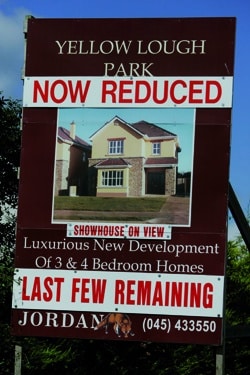NAMA’s interest in property price-rises clashes with the economic imperative to improve competitiveness
Gary Fitzgerald

Over the past six months the government has taken two key policy decisions. In October the National Asset Management Agency (NAMA) was set up to tackle the crisis in the financial sector, and in December Brian Lenihan delivered a tough budget. Taken together these moves are the centrepiece of the government’s attempt to deal with the economic crisis. According to the government they are essential building blocks in Ireland’s economic recovery. But there is a fundamental contradiction between the two and it is necessary to ask if it is possible to reconcile this difference. The aim of the budget was twofold. It needed to make deep cuts in public spending so as to reduce the government’s deficit, and to drive down costs in the economy so that Ireland can regain its competitiveness. There is no real secret to what “regaining competitiveness” means. Driving down costs means driving down wages. In a globalised world we Irish pay ourselves too much. This is not just limited to public sector workers, wages in the private sector must also fall for us to re-attract foreign investment. The problem here is that unless the cost of living decreases as well, then a large section of the country will experience significant hardship and poverty.
The single biggest item of expenditure for most, is the cost of mortgage repayments or rent. During the boom, wages had to rise to allow people to buy or rent homes. Now property prices and rent are going in the opposite direction and have a lot further to fall before there is real value in the market. This is especially true for house prices. A three bedroom house can be rented in Phibsboro for about €1000 per month. The same house is on the market for €450,000. At current rates of interest the repayment on a 30-year mortgage is €1700 per month. Over the next few years this is likely to increase as the European Central Bank increases interest rates. There is a huge additional expense in home ownership. This suggests that house prices must fall even further if they are to be affordable. Why buy a house when you can rent the same house for 50% less?
More evidence that house prices have further to fall comes from the American system of property valuation. There the value of a house is a calculated by reference to the rent. As a general rule a property is valued at 14 times the annual rent. Annual rent is taken as only 11 months; the final month’s rent is put towards the upkeep of the property. The three-bedroom house in Phibsboro has an annual rental return of €11,000, giving it a value of €154,000, a further fall of 75% from the advertised price of €450,000. This price is based on the assumption that rents will stay static. In fact, despite a recent blip, rents, generally, are also falling. In a rational housing market this will further drive down prices. This is great news for those looking to buy property and for the economy in general. Lower house prices will allow the government to meet the first of its aims, lowering costs in the economy to increase our competitiveness.
However, it is not good news for the other element of the government’s response to our economic ills, NAMA. The agency will buy €77 billion of property loans for about €54 billion. The government acknowledges that €7 billion of that is a deliberate overpayment above current market values. It claims that as property prices are at a low ebb it is acceptable to pay a premium. In the government’s view this overpayment represents the long-term economic value of those assets. According to Brian Lenihan, in order for NAMA to make a modest profit the property market will only have to grow by 1% a year for the next 10 years. If he is wrong about the direction of the property market then NAMA will make a loss. That may be anywhere from €10 – €30 billion. Needless to say this loss will be picked up by the tax-payer.
There are two problems with the assumption of growth in the property market. The first is that any increase in property prices might benefit NAMA but it will reduce our competitiveness. Government policy is to drive down costs and prices to make us competitive again, yet it bases its NAMA figures on an increase in the key price of property in the economy. The second problem is that property prices are nowhere near the bottom of the market. It makes no sense to buy in a falling market when renting a property is 40% cheaper than mortgage repayments. This is certainly the case when interest rates are expected to double in the short to medium term. At some point over the next few years the unstoppable force of NAMA will collide with the immoveable object of competitiveness. NAMA requires property prices to increase or else the taxpayer will be left with a bill running into billions of Euros. Economic recovery requires prices to fall in order for us to regain our competitiveness. These two policy objectives are inherently contradictory. I cannot see a way to reconcile them. My hope is that someone in government has a plan to deal with this contradiction.
Gary Fitzgerald is the Green Party representative for Cabra, Glasnevin, Phibsboro, Drumcondra and the Navan Road